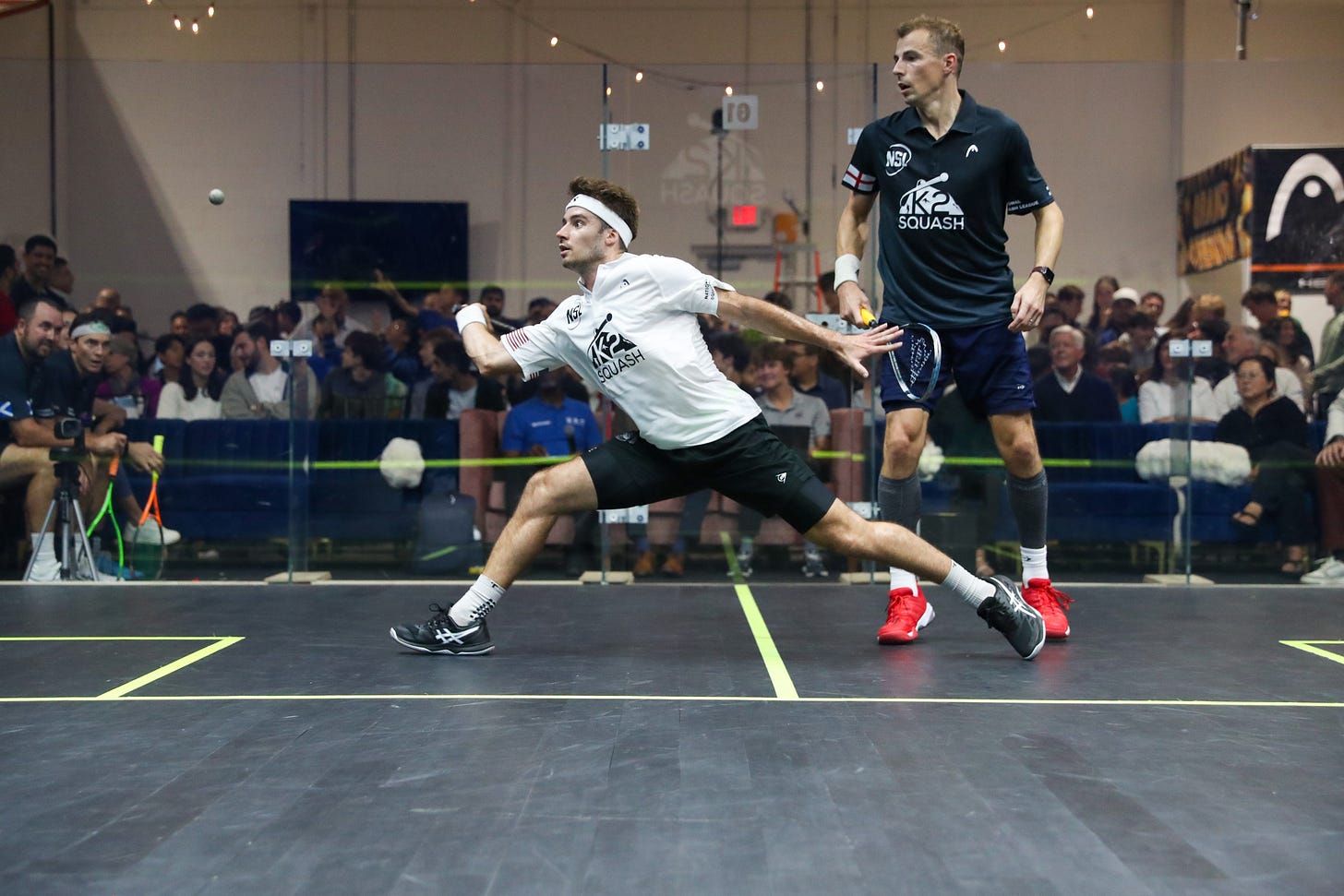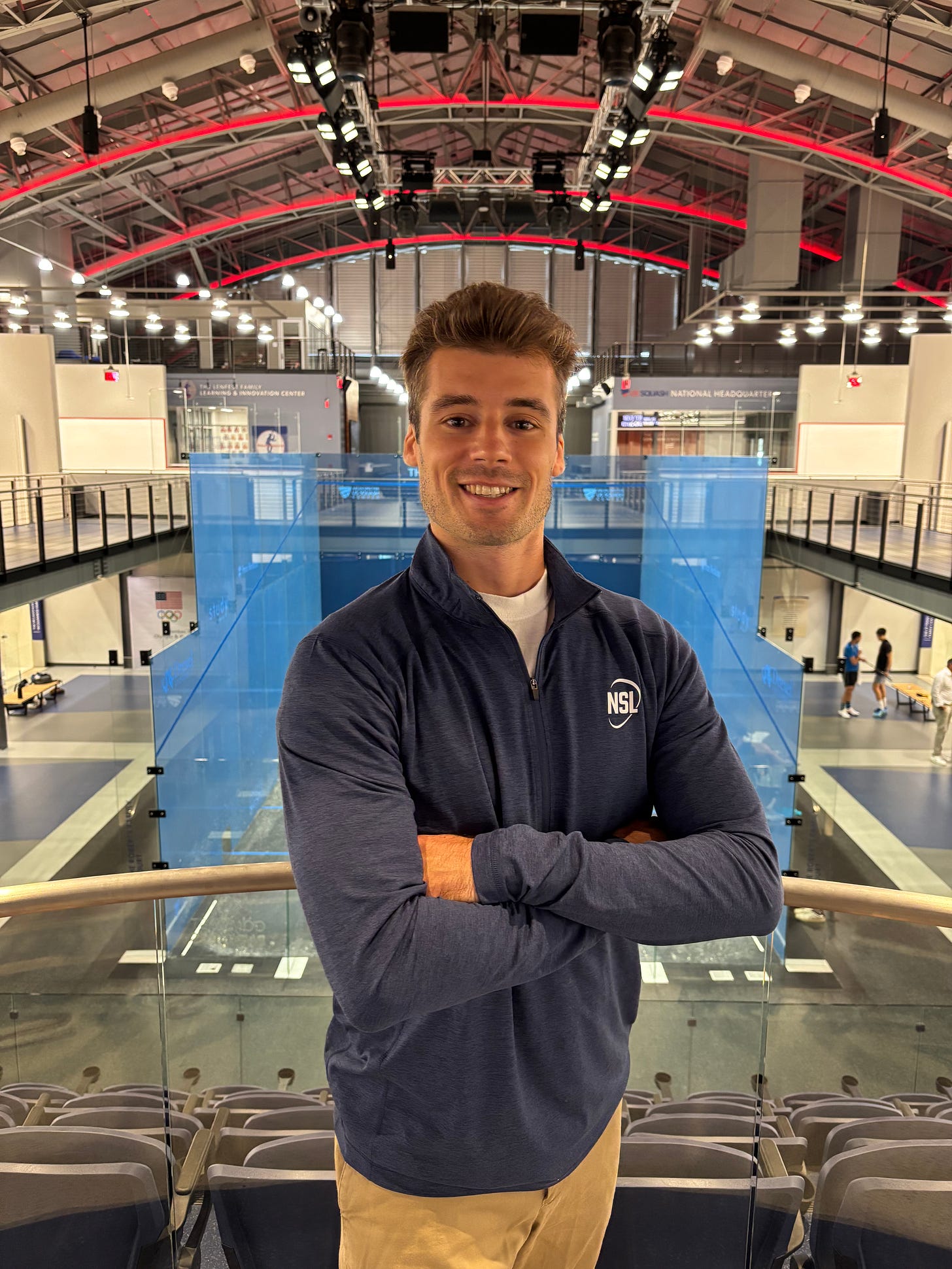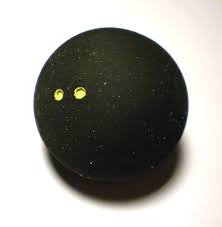Summer of Squash
A subscriber to Clubland USA, particularly a club rat from the South, thanked me for providing such good squash coverage. Unfortunately, I can’t take credit for the hard work that Ishaan Jajodia has done to bring news of Clubland’s hottest sport to the greater club world.
This week, as many of our readers recline in their summer clubs and some even in their summer homes, Ishaan brings exclusive members-only content about the National Squash League’s Spencer Lovejoy who is retiring from the professional squash tour to enhance the league’s growth.
We will also be resurfacing some of the best works of Clubland USA in recent months and happily awaiting your suggestions of what we should write about next as the fall approaches.
As always, please share this special issue of Clubland USA and encourage them to subscribe with our unique referral code below.—LR
The Man Changing The Way Squash Is Watched
Clubland USA sits down with Spencer Lovejoy
It’s impossible to play squash at the New Haven Lawn Club without hearing the name Spencer Lovejoy, who, at eight, crossed over from the light side—tennis courts—to the windowless basement dwellers that the squash players are. Almost two decades after he first picked up a squash racquet, Lovejoy, now 27, announced his retirement from the professional squash tour earlier this month to become the CEO of the National Squash League, having reached an all-time high world ranking of 64.
Clubland USA sat down with Lovejoy last week.
The National Squash League is one of those things you don’t really see very often in the squash world: revolutionary. When you walk onto a squash court, you’ve been removed from a sense of time and place: you’re stuck in time. The only thing that counts is the ball, your opponent, and you.
However, when Lovejoy was playing on the professional squash tour, he commonly encountered “people [who] used to ask me when I played pro, ‘What team do I play for?’” The very popularity of team sports in the United States, from football to hockey to basketball, causes spectators who have not already been initiated into the cult of squash to wonder where the camaraderie and the team-spirit is lurking.
It is not that team play is alien to the world of squash: college squash is centered around teams, and national teams are pitted against each other in the Pan-American Games, among other tournaments. League play is an important social glue for the squash world, for amateurs and professionals alike. European squash leagues with high-profile players have sprung up in Germany and the Netherlands, but league play has remained more or less alien to the world of American squash. There has not been anyone who has attempted to bring this stateside besides Lovejoy, Timmy Brownell, and Fernando Valdizan.
The National Squash League, however, also goes further format-wise than any of their European counterparts. NSL teams field three players a side, and games are divided into two twenty-minute segments and a final thirty-minute segment. Players can be substituted, and powerplays, when only the team who has called a powerplay can score, too, are novel additions to the way the sport is played. Bringing tools from other American sports—basketball and football—into the squash world can prove to be a truly potent tonic for the sleepy backwaters that professional squash can oftentimes be.
The National Squash League finished its first season in 2024, and the second in 2025. The first season featured six teams in two divisions, which rapidly expanded to nine men’s teams across three divisions and four women’s teams across two divisions by 2025. The winner of each division, along with a wildcard, advances to playoffs. —IJ
Please click here to continue reading more about the National Squash League and its CEO, Spencer Lovejoy.
Squash Whites Only

While walking past the University Club on our way to the Tournament of Champions, a friend regaled us with a tale of a sign that once stood on the threshold of their squash courts: whites only. Now, if you’re terminally online, I know what you’re thinking, and you’re more shades of wrong than there are of khaki. The pomp and circumstance of walking through the entrance to the squash courts or to the tennis courts, wearing whites, and then proceeding to play: almost like a uniform, yes, but also, a visual signifier that both players understand the ends and the means that they are about to deploy on court. But it is not merely the aesthetic dimension that ought to grab our eye. There is ritual, much needed and long missed ritual, in the everyday routine of finding oneself on court, serving, playing, winning and losing, and then doing it all over again.
Much of New Haven knows for a fact that for an hour after noon I will always be unreachable, that important things happen either before or after, but with enough leeway to prevent me making my way to the courts, five days a week. But I can adopt Martin Luther’s line of defence and remark, Here I stand, I can do no other—for I can truly do no other. — IJ
Please click here to continue reading.
Squash 101
It’s no secret that Clubland’s favourite sport (or, at any rate, mine), is squash.
I grew up playing one racquet sport or the other. At eight, I was ceremoniously handed a full-sized squash racquet—I remember distinctly that it was almost the same size as me, and thus began a lifelong fascination with busting balls.
Whether you’ve been playing since you were eight, or this is your eighth day on court, it’s never a bad time to have a glance at the rules.
At its best moments, squash is fiercely competitive, yet remarkably elegant. The shuffling of players around the T is an intricate dance that at any moment can veer toward massacre and bloodshed. And—let’s not forget the walls—which add complexity, with the rubber ball sticking to it in the most inopportune moments, making it nigh impossible to dig it out and return it to the front wall. —IJ
Please click here to continue reading.
Dispatches from the T:
A brief introduction to various club sports, including squash, written by yours truly can be found ordered to the dictum, Smaller the Ball, Better the Sport. The small print for the smallest club sport ball is at Squash 101.
In When Clubland Invades Grand Central, we go to visit the Tournament of Champions at Grand Central Terminal in New York City, where some of the world’s best players square off against each other in Vanderbilt Hall.
Continuing the trend of watching squash games, Clubland USA makes an appearance at a National Squash League game in Squash Pros and Skyscrapers.
And, finally, we visit perhaps the greatest of the club squash tournaments extant today, the Toledo Squash Classic at the Toledo Club, in Glass City Squash.



